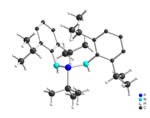Compounds with a MNP Skeleton
Compounds with an MNP Skeleton
Reactions of aminophosphines with organo-element compounds of the group 13 elements were investigated in order to build "ternary compounds" with a cyclic or acyclic skeleton of three different group 13/ 15 elements. Compounds of the type P(NH2)3, RP(NH2)2, R2PNH2 or RP(NHR')2 with reactive (protic) N-H functions were expected to be suitable for the synthesis of ternary compounds by reactions with group 13 trialkyls or hydrides.
In contrast to easily accessible dialkylaminophosphines RxP(NR'2)3-x, the synthesis of alkylaminophosphines RxP(NHR')3-x and aminophosphines RxP(NH2)3-x (x = 1, 2, 3) is more difficult due to their increased condensation fragility. With elimination of amine cyclic or low coordinated iminophosphines are formed. By using strongly electronegative and/or sterically demanding ligands, or by coordination to a metal fragment such condensation reactions can be suppressed.
During our research, we synthesize stable aminophosphines which were then reacted with suitable organometallic compounds. We concentrated on reactions of alkyl-bis(alkylamino)phosphines P(NHR')2, bis(dialkylamino)aminophosphines (R2N)2PNH2 and alkyl-bis(amino)phosphines RP(NH2)2.
Aminophosphines
1. Introduction
Dialkylaminophosphines of the type RxP(NR'2)3-x (x = 2, 1, 0) were synthesized first by Michaelis [1]. Since then, a large number of compounds of types 1-3 were synthesized and extensive studies on their reactivity were realized.

Figure 1: Structures of selected aminophosphines
Alkylaminophosphines RxP(NHR')3-x and aminophosphines RxP(NH2)3-x are less easy to synthesize, due to their strong condensation tendency. With elimination of amine cyclic or low coordinated iminophosphines are preferentially formed [2]. By using strongly electronegative and/or sterically demanding ligands, or by coordination to a metal fragment the condensation tendency can be suppressed. For example, trisaminophosphine P(NH2)3, which is unstable in its pure form, can be stabilized by coordination to BH3 or pentacarbonyl metal fragments (M = Cr, Mo, W) [3].
2. Synthesis and Structure
The easiest method for the preparation of alkyl-bis(alkylamino)phosphines RP(NHR')2 is the base-supported HCl elimination route starting with organochlorophosphines and an excess of a primary amine, which, however, are only in the case of sterically less demanding amines successfull. In contrast, salt elimination reactions between organochlorophosphines and two equivalents of a Li-amide are also possible with sterically demanding substituted amines.

Figure 2: Synthesis of bis(alkylamino)phosphines RP(NHR')2
Bis(dialkylamino)aminophosphines (R2N)2PNH2 are preferably synthesized by ammonolysis of the corresponding Cl-substituted compound.

Figure 3: Molecular structure of t-BuP(N(H)Dipp)2 (Dipp = 2,6-(i-Pr)2C6H3
3. References
[1] (a) A. Michaelis, H. v. Soden, Ann. d. Chem. 1885, 229, 334. (b) A. Michaelis, G. Schulze, Chem. Ber. 1893, 26, 2937. (c) A. Michaelis, G. Schulze, Chem. Ber. 1894, 27, 2572. (d) A. Michaelis, K. Luxembourg, Chem. Ber. 1895, 28, 2205.
[2] (a) R. A. Keat, Top. Curr. Chem. 1982, 102, 89. (b) N. Burford, J. A. C. Clyburne, S. Mason, J. F. Richardson, Inorg. Chem. 1993, 32, 4988.
[3] Siehe z. B. (a) D. W. W. Anderson, J. E. Bentham, D. W. H. Rankin, J. Chem. Soc., Dalton Trans. 1973, 1215. (b) A. Kodama, R. W. Parry, J. Inorg. Nucl. Chem. 1961, 17, 125. (c) C. E. Nordman, Acta. Cryst. 1960, 13, 535. (d) H. Nöth, H. Reith, V. Thorn, J. Organomet. Chem. 1978, 159, 165. (e) A. Gieren, F. C. Ruiz-Pérez, T. Hübner, M. Herberhold, K. Schamel, K. Guldner, J. Organomet. Chem. 1989, 366, 105. (f) B. Wrackmeyer, K. Schamel, M. Herberhold, Z. Naturforsch. 1989, 44b, 55.
